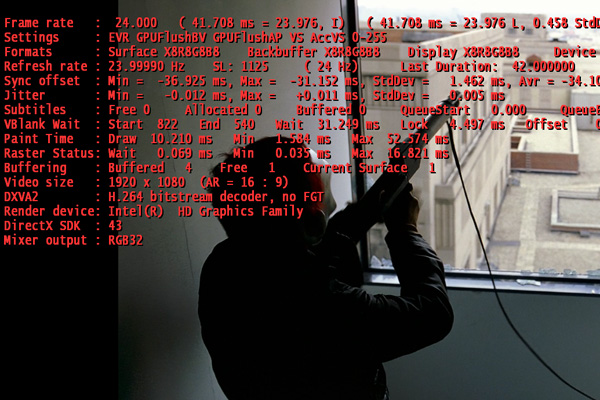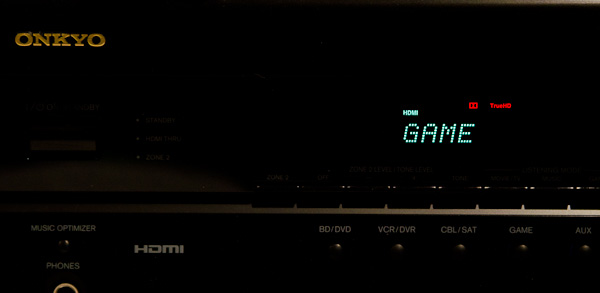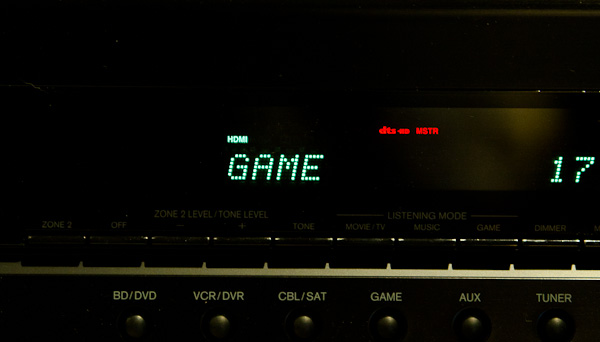The Sandy Bridge Review: Intel Core i7-2600K, i5-2500K and Core i3-2100 Tested
by Anand Lal Shimpi on January 3, 2011 12:01 AM ESTA Near-Perfect HTPC
Since 2006 Intel’s graphics cores have supported sending 8-channel LPCM audio over HDMI. In 2010 Intel enabled bitstreaming of up to eight channels of lossless audio typically found on Blu-ray discs via Dolby TrueHD and DTS-HD MA codecs. Intel’s HD Graphics 3000/2000 don’t add anything new in the way of audio or video codec support.
Dolby Digital, TrueHD (up to 7.1), DTS, DTS-HD MA (up to 7.1) can all be bitstreamed over HDMI. Decoded audio can also be sent over HDMI. From a video standpoint, H.264, VC-1 and MPEG-2 are all hardware accelerated. The new GPU enables HDMI 1.4 and Blu-ray 3D support. Let’s run down the list:
Dolby TrueHD Bitstreaming? Works:
DTS HD-MA bitstreaming? Yep:
Blu-ray 3D? Make that three:
How about 23.976 fps playback? Sorry guys, even raking in $11 billion a quarter doesn’t make you perfect.
Here’s the sitch, most movie content is stored at 23.976 fps but incorrectly referred to as 24p or 24 fps. That sub-30 fps frame rate is what makes movies look like, well, movies and not soap operas (this is also why interpolated 120Hz modes on TVs make movies look cheesey since they smooth out the 24 fps film effect). A smaller portion of content is actually mastered at 24.000 fps and is also referred to as 24p.
In order to smoothly playback either of these formats you need a player and a display device capable of supporting the frame rate. Many high-end TVs and projectors support this just fine, however on the playback side Intel only supports the less popular of the two: 24.000Hz.
This isn’t intentional, but rather a propagation of an oversight that started back with Clarkdale. Despite having great power consumption and feature characteristics, Clarkdale had one glaring issue that home theater enthusiasts discovered: despite having a 23Hz setting in the driver, Intel’s GPU would never output anything other than 24Hz to a display.
The limitation is entirely in hardware, particularly in what’s supported by the 5-series PCH (remember that display output is routed from the processor’s GPU to the video outputs via the PCH). One side effect of trying to maintain Intel’s aggressive tick-tock release cadence is there’s a lot of design reuse. While Sandy Bridge was a significant architectural redesign, the risk was mitigated by reusing much of the 5-series PCH design. As a result, the hardware limitation that prevented a 23.976Hz refresh rate made its way into the 6-series PCH before Intel discovered the root cause.
Intel had enough time to go in and fix the problem in the 6-series chipsets, however doing so would put the chipset schedule at risk given that fixing the problem requires a non-trivial amount of work to correct. Not wanting to introduce more risk into an already risky project (brand new out of order architecture, first on-die GPU, new GPU architecture, first integrated PLL), Intel chose to not address it this round, which is why we still have the problem today.

Note the frame rate
What happens when you try to play 23.976 fps content on a display that refreshes itself 24.000 times per second? You get a repeated frame approximately every 40 seconds to synchronize the source frame rate with the display frame rate. That repeated frame appears to your eyes as judder in motion, particularly evident in scenes involving a panning camera.
How big of an issue this is depends on the user. Some can just ignore the judder, others will attempt to smooth it out by setting their display to 60Hz, while others will be driven absolutely insane by it.
If you fall into the latter category, your only option for resolution is to buy a discrete graphics card. Currently AMD’s Radeon HD 5000 and 6000 series GPUs correctly output a 23.976Hz refresh rate if requested. These GPUs also support bitstreaming Dolby TrueHD and DTS-HD MA, while the 6000 series supports HDMI 1.4a and stereoscopic 3D. The same is true for NVIDIA’s GeForce GT 430, which happens to be a pretty decent discrete HTPC card.
Intel has committed to addressing the problem in the next major platform revision, which unfortunately seems to be Ivy Bridge in 2012. There is a short-term solution for HTPC users absolutely set on Sandy Bridge. Intel has a software workaround that enables 23.97Hz output. There’s still a frame rate mismatch at 23.97Hz, but it would be significantly reduced compared to the current 24.000Hz-only situation.
MPC-HC Compatibility Problems
Just a heads up. Media Player Classic Home Cinema doesn't currently play well with Sandy Bridge. Enabling DXVA acceleration in MPC-HC will cause stuttering and image quality issues during playback. It's an issue with MPC-HC and not properly detecting SNB as far as I know. Intel has reached out to the developer for a fix.














283 Comments
View All Comments
-=Hulk=- - Monday, January 3, 2011 - link
That's crazy, are the chipsets PCI-e line still limited to v1 (250MB/s) speed or what????http://images.anandtech.com/reviews/cpu/intel/sand...
mino - Monday, January 3, 2011 - link
No, you read it wrong.There are altogether 8 PCIE 2.0 linex and all can be used independently, aka s as "PCIe x1".
The CPU-Chipset bandwith however is a basic PCIe x4 link, so do not expect wonders is more divices are in heavy use ...
-=Hulk=- - Monday, January 3, 2011 - link
No!Look at the PCI-e x16 from the CPU. Intel indicates a bandwidth of 16GB/s per line. That means 1GB/s per line.
But PCI-e v2 has a bandwidth of 500MB/s per line only. Thats mean that the values that Intel Indicates for the PCI-e lines are the sum of the upload AND download bandwidth of the PCI-e.
Thats means that the PCI-e lines of the chipset run at 250MB/s speed! That is the bandwidth of the PCI-e v1, and Intel has done the same bullshit with the P55/H57, he indicates that they are PCI-e v2 but they limits their speed to the values of the PCI-e v1:
P55 chipset (look at the 2.5GT/s !!!) :
"PCI Express* 2.0 interface:
Offers up to 2.5GT/s for fast access to peripheral devices and networking with up to 8 PCI Express* 2.0 x1 ports, configurable as x2 and x4 depending on motherboard designs.
http://www.intel.com/products/desktop/chipsets/p55... "
P55, also 500MB/s per line as for the P67
http://benchmarkreviews.com/images/reviews/motherb...
Even for the ancient ICH7 Intel indicates 500MB/s per line, but at that time PCI-e v didn't even exist... That's because it's le sum of the upload and download speed of the PCI-e v1.
http://img.tomshardware.com/us/2007/01/03/the_sout...
DanNeely - Monday, January 3, 2011 - link
Because 2.0 speed for the southbridge lanes has been reported repeatedly (along with a 2x speed DMI bus to connect them), my guess is an error when making the slides with bidirectional BW listed on the CPU and unidirectional BW on the southbridge.jmunjr - Monday, January 3, 2011 - link
Intel's sell out to big media and putting DRM in Sandy Bridge means I won't be getting one of these puppies. I don't care how fast it is...Exodite - Monday, January 3, 2011 - link
Uh, what exactly are you referencing?If it's TXT it's worth noting that the interesting chips, the 2500K and 2600K, doesn't even support it.
chirpy chirpy - Tuesday, January 11, 2011 - link
I think the OP is referring to Intel Insider, the not-so-secret DRM built into the sandy bridge chips. I can't believe people are overlooking the fact that Intel is attempting to introduce DRM at the CPU level and all everyone has to say is "wow, I can't WAIT to get one of dem shiny new uber fast Sandy Bridges!"I for one applaud and welcome our benevolent DRM overlords.....
http://www.pcmag.com/article2/0,2817,2375215,00.as...
nuudles - Monday, January 3, 2011 - link
I have a q9400, if I compare it to the 2500K in bench and average (straight average) all scores the 2500K is 50% faster. The 2500K has a 24% faster base clock, so all the architecture improvements plus faster RAM, more cache and turbo mode gained only ~20% or so on average, which is decent but not awesome taking into account the c2q is 3+ year old design (or is it 4 years?). I know that the idle power is significantly lower due to power gating so due to hurry up and wait it consumes less power (cant remember c2q 45nm load power, but it was not much higher than this core 2011 chips).So 50%+ faster sounds good (both chips occupy the same price bracket), but after equating clock speeds (yes it would increase load and idle power on the c2q) the improvement is not massive but still noticeable.
I will be holding out for Bulldozer (possibly slightly slower, especially in lightly threaded workloads?) or Ivy Bridge as mine is still fast enough to do what I want, rather spend the money on adding a SSD or better graphics card.
7Enigma - Monday, January 3, 2011 - link
I think the issue with the latest launch is the complete and utter lack of competition for what you are asking. Anand's showed that the OC'ing headroom for these chips are fantastic.....and due to the thermals even possible (though not recommended by me personally) on the stock low-profile heatsink.That tells you that they could have significantly increased the performance of this entire line of chips but why should they when there is no competition in sight for the near future (let's ALL hope AMD really produces a winner in the next release) or we're going to be dealing with a plodding approach with INTEL for a while. In a couple months when the gap shrinks (again hopefully by a lot) they simply release a "new" batch with slightly higher turbo frequencies (no need to up the base clocks as this would only hurt power consumption with little/no upside), and bam they get essentially a "free" release.
It stinks as a consumer, but honestly probably hurts us enthusiasts the least since most of us are going to OC these anyways if purchasing the unlocked chips.
I'm still on a C2D @ 3.85GHz but I'm mainly a gamer. In a year or so I'll probably jump on the respin of SDB with even better thermals/OC potential.
DanNeely - Monday, January 3, 2011 - link
CPUs need to be stable in Joe Sixpack's unairconditioned trailer in Alabama during August after the heatsink is crusted in cigarette tar and dust, in one of the horrible computer desks that stuff the tower into a cupboard with just enough open space in the back for wires to get out; not just in an 70F room where all the dust is blown out regularly and the computer has good airflow. Unless something other than temperature is the limiting factor on OC headroom that means that large amounts of OCing can be done easily by those of us who take care of their systems.Since Joe also wants to get 8 or 10 years out of his computer before replacing it the voltages need to be kept low enough that electromigration doesn't kill the chip after 3 or 4. Again that's something that most of us don't need to worry about much.